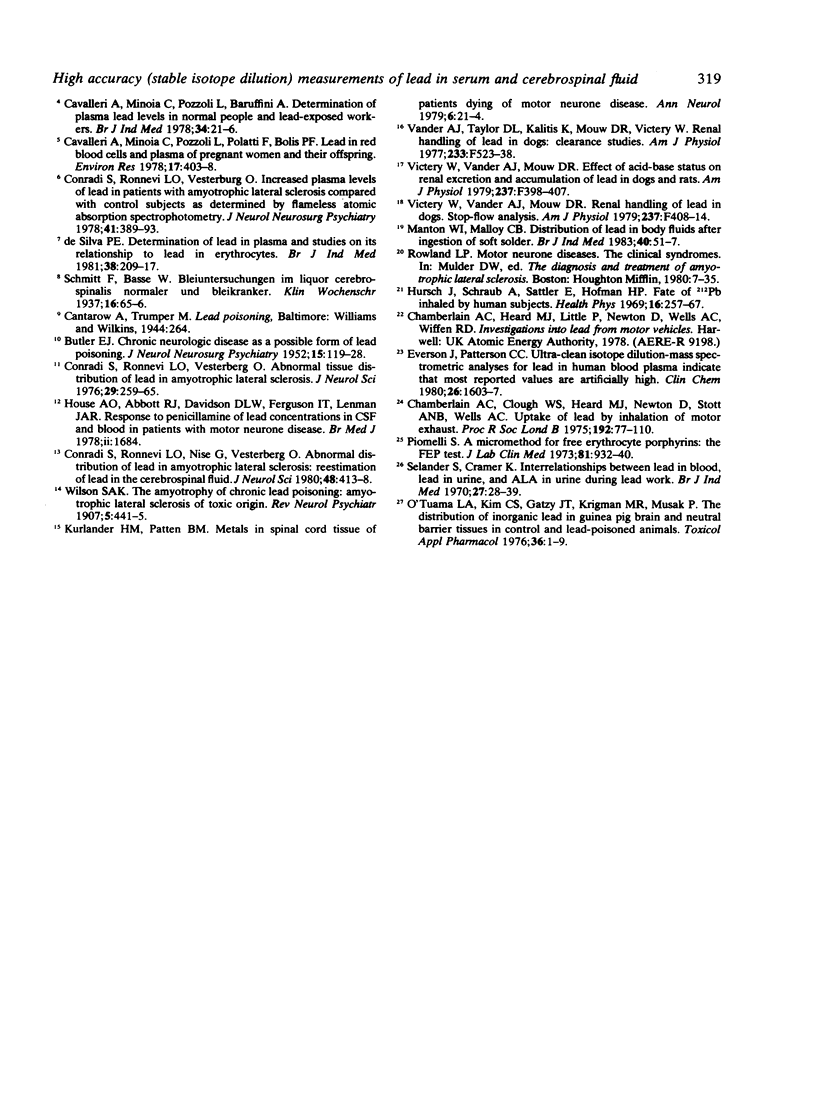Abstract
The concentration of lead in blood, serum, cerebrospinal fluid, and urine was measured in patients with neurological disease and in control subjects including cases of plumbism. A plot of blood lead versus serum lead resembles the familiar curves of blood lead versus either free erythrocyte porphyrin or urinary delta-aminolaevulinic acid in that serum lead is constant up to a blood lead concentration of 40 micrograms/dl (2 mumol/l) and rises steeply thereafter. The serum lead concentrations yield renal clearances in the range 5-22 ml/min in agreement with values obtained with radiolead on man and predicted from animal studies. The lead content of cerebrospinal fluid is consistently less than that of serum, averaging 50% of the serum concentration for blood leads of less than 20 micrograms/dl (1 mumol/l) but rising to 80-90% in cases of plumbism. Patients with motor neurone disease could not be distinguished from those with other neurological diseases on the basis of the lead content of their serum or cerebrospinal fluid.
Full text
PDF






Selected References
These references are in PubMed. This may not be the complete list of references from this article.
- BUTLER E. J. Chronic neurological disease as a possible form of lead poisoning. J Neurol Neurosurg Psychiatry. 1952 May;15(2):119–128. doi: 10.1136/jnnp.15.2.119. [DOI] [PMC free article] [PubMed] [Google Scholar]
- Cavalleri A., Minoia C., Pozzoli L., Baruffini A. Determination of plasma lead levels in normal subjects and in lead-exposed workers. Br J Ind Med. 1978 Feb;35(1):21–26. doi: 10.1136/oem.35.1.21. [DOI] [PMC free article] [PubMed] [Google Scholar]
- Cavalleri A., Minoia C., Pozzoli L., Polatti F., Bolis P. F. Lead in red blood cells and in plasma of pregnant women and their offspring. Environ Res. 1978 Dec;17(3):403–408. doi: 10.1016/0013-9351(78)90043-9. [DOI] [PubMed] [Google Scholar]
- Chamberlain A. C., Clough W. S., Heard M. J., Newton D., Stott A. N., Wells A. C. Uptake of lead by inhalation of motor exhaust. Proc R Soc Lond B Biol Sci. 1975 Dec 31;192(1106):77–110. doi: 10.1098/rspb.1975.0152. [DOI] [PubMed] [Google Scholar]
- Conradi S., Ronnevi L. O., Nise G., Vesterberg O. Abnormal distribution of lead in amyotrophic lateral sclerosis--reestimation of lead in the cerebrospinal fluid. J Neurol Sci. 1980 Dec;48(3):413–418. doi: 10.1016/0022-510x(80)90112-4. [DOI] [PubMed] [Google Scholar]
- Conradi S., Ronnevi L. O., Vesterberg O. Abnormal tissue distribution of lead in amyotrophic lateral sclerosis. J Neurol Sci. 1976 Oct;29(2-4):259–265. doi: 10.1016/0022-510x(76)90175-1. [DOI] [PubMed] [Google Scholar]
- Conradi S., Ronnevi L. O., Vesterberg O. Increased plasma levels of lead in patients with amyotrophic lateral sclerosis compared with control subjects as determined by flameless atomic absorption spectrophotometry. J Neurol Neurosurg Psychiatry. 1978 May;41(5):389–393. doi: 10.1136/jnnp.41.5.389. [DOI] [PMC free article] [PubMed] [Google Scholar]
- Everson J., Patterson C. C. "ULtra-clean" isotope diultion/mass spectrometic analyses for lead in human blood plasma indicated that most reported values are artificially high. Clin Chem. 1980 Oct;26(11):1603–1607. [PubMed] [Google Scholar]
- House A. O., Abbott R. J., Davidson D. L., Ferguson I. T., Lenman J. A. Response to penicillamine of lead concentrations in CSF and blood in patients with motor neurone disease. Br Med J. 1978 Dec 16;2(6153):1684–1684. doi: 10.1136/bmj.2.6153.1684. [DOI] [PMC free article] [PubMed] [Google Scholar]
- Hursh J. B., Schraub A., Sattler E. L., Hofmann H. P. Fate of 212Pb inhaled by human subjects. Health Phys. 1969 Mar;16(3):257–267. doi: 10.1097/00004032-196903000-00001. [DOI] [PubMed] [Google Scholar]
- Kurlander H. M., Patten B. M. Metals in spinal cord tissue of patients dying of motor neuron disease. Ann Neurol. 1979 Jul;6(1):21–24. doi: 10.1002/ana.410060105. [DOI] [PubMed] [Google Scholar]
- O'Tuama L. A., Kim C. S., Gatzy J. T., Krigman M. R., Mushak P. The distribution of inorganic lead in guinea pig brain and neural barrier tissues in control and lead-poisoned animals. Toxicol Appl Pharmacol. 1976 Apr;36(1):1–9. doi: 10.1016/0041-008x(76)90021-1. [DOI] [PubMed] [Google Scholar]
- Piomelli S. A micromethod for free erythrocyte porphyrins: the FEP test. J Lab Clin Med. 1973 Jun;81(6):932–940. [PubMed] [Google Scholar]
- ROBINSON M. J., KARPINSKI F. E., Jr, BRIEGER H. The concentration of lead in plasma, whole blood and erythrocytes of infants and children. Pediatrics. 1958 May;21(5):793–797. [PubMed] [Google Scholar]
- Selander S., Cramér K. Interrelationships between lead in blood, lead in urine, and ALA in urine during lead work. Br J Ind Med. 1970 Jan;27(1):28–39. doi: 10.1136/oem.27.1.28. [DOI] [PMC free article] [PubMed] [Google Scholar]
- Victery W., Vander A. J., Mouw D. R. Effect of acid-base status on renal excretion and accumulation of lead in dogs and rats. Am J Physiol. 1979 Nov;237(5):F398–F407. doi: 10.1152/ajprenal.1979.237.5.F398. [DOI] [PubMed] [Google Scholar]
- Victery W., Vander A. J., Mouw D. R. Renal handling of lead in dogs: stop-flow analysis. Am J Physiol. 1979 Nov;237(5):F408–F414. doi: 10.1152/ajprenal.1979.237.5.F408. [DOI] [PubMed] [Google Scholar]
- deSilva P. E. Determination of lead in plasma and studies on its relationship to lead in erythrocytes. Br J Ind Med. 1981 Aug;38(3):209–217. doi: 10.1136/oem.38.3.209. [DOI] [PMC free article] [PubMed] [Google Scholar]


